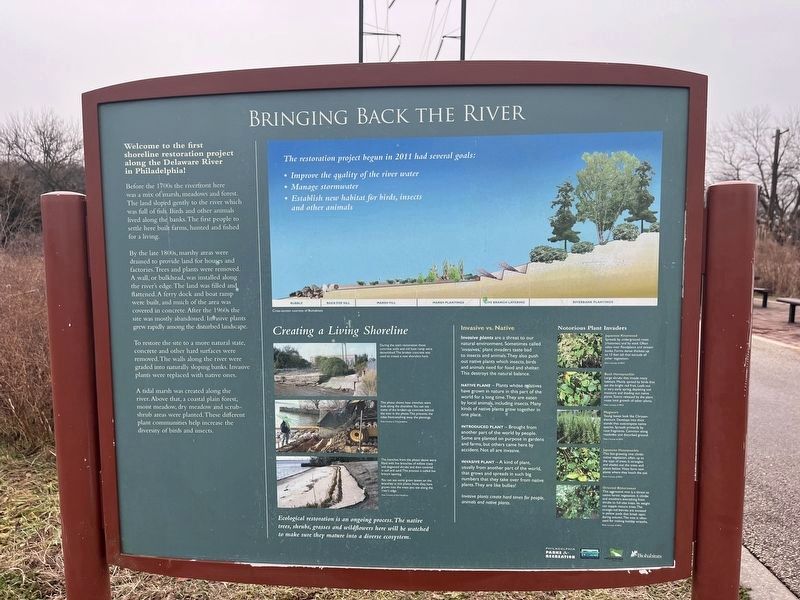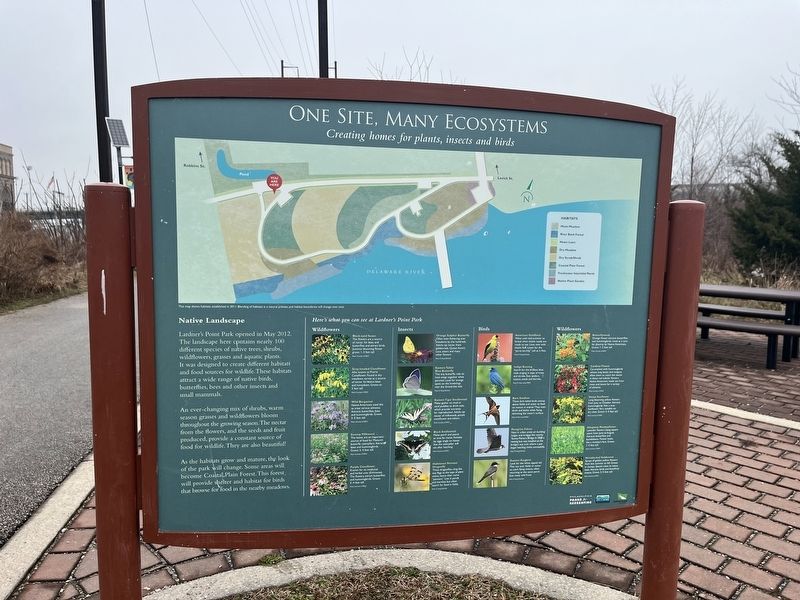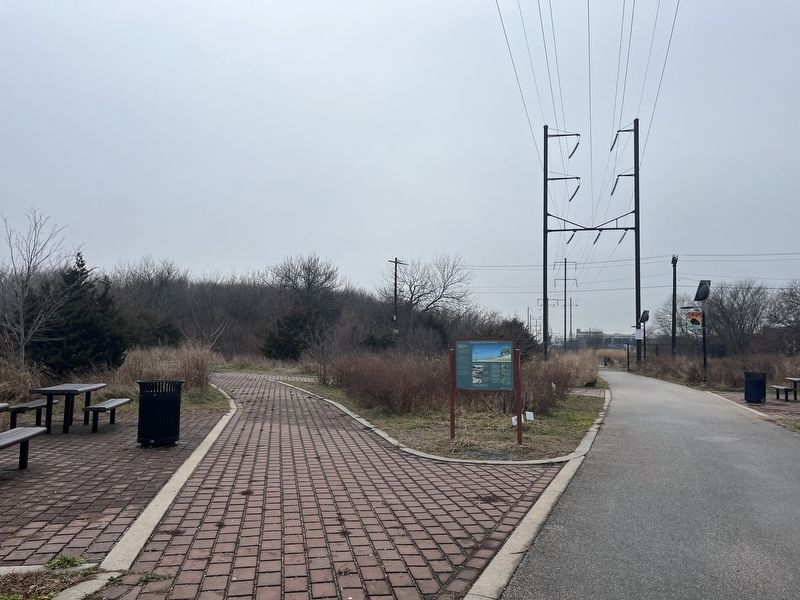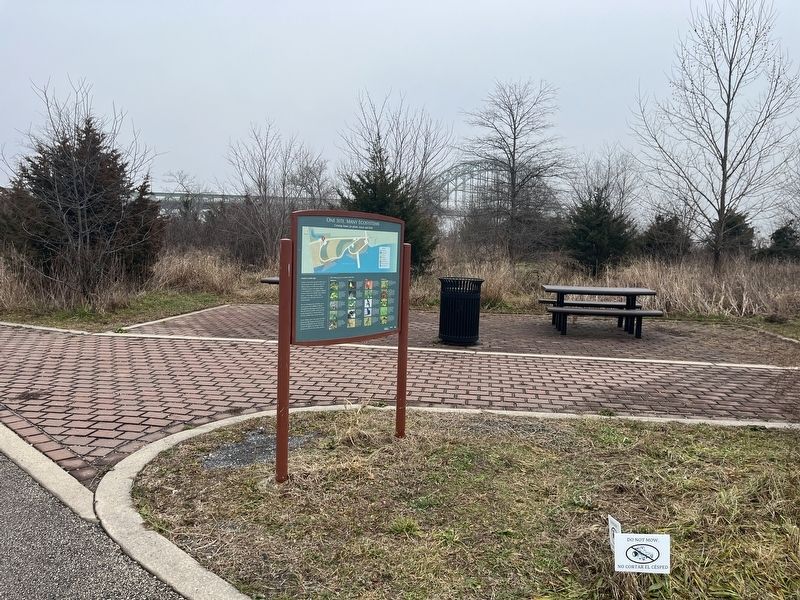Tacony in Philadelphia in Philadelphia County, Pennsylvania — The American Northeast (Mid-Atlantic)
Bringing Back the River / One Site, Many Ecosystems

Photographed By Devry Becker Jones (CC0), January 26, 2024
1. Bringing Back the River side of the marker
Welcome to the first shoreline restoration project along the Delaware River in Philadelphia!
Before the 1700s the riverfront here was a mix of marsh, meadows and forest. The land sloped gently to the river which was full of fish. The first people to settle here built farms, hunted and fished for a living.
By the late 1800s, marshy areas were drained to provide land for houses and factories. Trees and plants were removed. A wall, or bulkhead, was installed along the river's edge. The land was filled and flattened. A ferry dock and boat ramp were built, and much of the area was covered in concrete. After the 1960s the site was mostly abandoned. Invasive plants grew rapidly among the disturbed landscape.
To restore the site to a more natural state, concrete and other hard surfaces were removed. The walls along the river were graded into naturally sloping banks. Invasive plants were replaced with native ones.
A tidal marsh was created along the river. Above that, a coastal plain forest, moist meadow, dry meadow and scrub-shrub areas were planted. These different plant communities help increase the diversity of birds and insects.
The restoration project begun in 2011 had several goals:
• Improve the quality of the river water
• Manage stormwater
• Establish new habitat for birds, insects and other animals
Creating a Living Shoreline
During the site's restoration these concrete walls and old boat ramp were demolished. The broken concrete was used to create a new shoreline here.
This photo shows how trenches were built along the shoreline. You can see some of the broken-up concrete behind the man in the photo. This prevents the tides from washing away the plantings.
The trenches from the photo above were filled with live branches of willow trees and dogwood shrubs and then covered in soil and sand. This process is called live branch layering.
You can see some green leaves on the branches in this photo. Now, they have grown into the trees you see along the river's edge.
Ecological restoration is an ongoing process. The native trees, shrubs, grasses and wildflowers here will be watched to make sure they mature into a diverse ecosystem.
Invasive vs. Native
Invasive plants are a threat to our natural environment. Sometimes called 'invasives,' plant invaders taste bad to insects and animals. They also push out native plants which insects, birds and animals need for food or shelter. This destroys the natural balance.
Native plant

Photographed By Devry Becker Jones (CC0), January 26, 2024
2. One Site, Many Ecosystems side of the marker
Introduced plant — Brought from another part of the world by people. Some are planted on purpose in gardens and farms, but others came here by accident. Not all are invasive.
Invasive plant — A kind of plant, usually from another part of the world, that grows and spreads in such big numbers that they take over from native plants. They are like bullies!
Invasive plants create hard times for people, animals and native plants.
Notorious Plant Invaders
Japanese Knotweed
Spreads by underground roots (rhizomes) and by seed. Often takes over floodplains and stream banks. Forms dense thickets up to 12 feet tall that exclude all other vegetation.
Bush Honeysuckle
Large shrubs that invade many habitats. Mainly spread by birds that eat the bright red fruit. Leafs out in very early spring, depleting soil moisture and shading out native plants. Toxins released by the plant roots limit growth of other plants.
Mugwort
Young leaves look like Chrysanthemum. Develops into thick stands that outcompete native species. Spreads primarily by root fragments. Common

Photographed By Devry Becker Jones (CC0), January 26, 2024
3. Bringing Back the River side of the marker
Japanese Honeysuckle
This fast-growing vine climbs native vegetation, often up to the tops of trees. It strangles and shades out the trees and plants below. Vines form new plants where they touch the soil.
Oriental Bittersweet
This aggressive vine is a threat to native forest vegetation. It climbs and smothers everything from shrubs to full-size trees. Its weight can topple mature trees. The orange-red berries are encased in yellow pods that break open during autumn. The vine is often used for making holiday wreaths.
Creating homes for plants, insects and birds
Native Landscape
Lardner's Point Park opened in May 2012. The landscape here contains nearly 100 different species of native trees, shrubs, wildflowers, grasses and aquatic plants. It was designed to create different habitats and food sources for wildlife. These habitats attract a wide range of native birds, butterflies, bees and other insects and small mammals.
An ever-changing mix of shrubs, warm season grasses and wildflowers bloom throughout the growing season. The nectar from the flowers, and the seeds and fruit produced, provide a constant source of food for wildlife. They are also beautiful!
As the

Photographed By Devry Becker Jones (CC0), January 26, 2024
4. One Site, Many Ecosystems side of the marker
Here's what you can see at Lardner's Point Park
Wildflowers
Black-eyed Susan
The flowers are a source of nectar for bees and butterflies and attract birds. Summer blooming flower grows 1-3 feet tall.
Gray-headed Coneflower
Also known as Prairie Coneflower. Found in dry meadows, serves as a source of nectar for native bees and honeybees. Grows to 5 feet tall.
Wild Bergamot
Native Americans used this to treat various ailments. Attracts butterflies, bees and hummingbirds. Grows 2-5 feet tall.
Swamp Milkweek
The leaves are an important source of food for Monarch butterfly caterpillars. Attracts bees and hummingbirds. Grows 2-4 feet feet tall.
Insects
Orange Sulphur Butterfly
Often seen fluttering over meadows by the hundreds. Adults sip nectar from goldenrods. Queen Anne's Lace, asters and many other flowers.
Eastern Tailed Blue Butterfly
This tiny butterfly rubs its hind wings together while perched. Look for orange spots on the hindwings near the thread-like tails.
Eastern Tiger Swallowtail
Males gather on mud or sand puddles to drink salts, which provide nutrients for reproduction. Adults sip nectar of milkweeds, purple coneflower and others.
Black Swallowtail
Males perch and patrol an area for mates. Females lay eggs singly on leaves that the caterpillar will eat after hatching.
Halloween Pennant Dragonfly
These dragonflies cling like tiny flags to the tops of plant stems, hence their name "penant." Live in ponds and marshes but often search for food in fields.
Birds
American Goldfinch
Waits until mid-summer to breed when thistle seeds are ready to eat. Lines nest with thistle fluff. Listen for the "po-ta-to-chip" call as it flies.
Indigo Bunting
Search for the brilliant blue male singing in tops of trees and shrubs. Eats spiders, insects, seeds and berries.
Barn Swallow
These fork-tailed birds swoop above fields and water to feed on insects in mid-air. They even drink and bathe while flying, skimming the water's surface.
Peregrine Falcon
Nest in urban areas on building ledges and bridges like nearby Tacony-Palmyra Bridge. In 2008 a nesting box was installed on the bridge's top arch where a pair began hatching chicks successfully.
Eastern Kingbird
Look for the white tipped tail. Flies out over fields or water to catch flying insects, often returning to the same perch. Eats many wild fruits.
Wildflowers
Butterflyweed
Orange flower attracts butterflies and hummingbirds. Used as a cure for pleurisy by Native Americans. Grows 1-2 feet tall.
Cardinal Flower
Co-evolved with hummingbirds whose long beaks and tongues allow them to reach the nectar in these red tubular flowers. Native Americans made tea from roots and leaves for a variety of ailments.
Oxeye Sunflower
Long blooming yellow flowers from June to October. Attracts hummingbirds. Not a true Sunflower. Very suitable on dry sites. Grows 3-5 feet tall.
Allegheny Monkeyflower
Lavender flowers along square stems from June to August. Attracts butterflies and bumblebees. Flower looks like a monkey's face. Grows 1-3 feet tall.
Wrinkle-leaf Goldenrod
Sprays of golden yellow flowers from late summer to fall. Grows in clumps. Special value to native bees. Attracts birds and beneficial insects. Grows 2-5 feet tall.
Erected by Philadelphia Parks & Recreation; Delaware River City Corp.; Rails-to-Trails Conservatory; Biohabitats.
Topics. This historical marker is listed in these topic lists: Environment • Native Americans • Parks & Recreational Areas • Settlements & Settlers. A significant historical year for this entry is 2011.
Location. 40° 0.853′ N, 75° 2.861′ W. Marker is in Philadelphia, Pennsylvania, in Philadelphia County. It is in Tacony. Marker is on K&T Trail west of Levick Street, on the right when traveling east. Touch for map. Marker is at or near this postal address: 5300 Robbins Street, Philadelphia PA 19135, United States of America. Touch for directions.
Other nearby markers. At least 8 other markers are within walking distance of this marker. Lardner's Point Pumping Station (within shouting distance of this marker); Tacony-Palmyra Bridge (about 400 feet away, measured in a direct line); Industry Along the River (about 400 feet away); Kensington and Tacony Railroad (about 400 feet away); Tacony-Palmyra Ferry Company (about 500 feet away); Lardner's Point (about 500 feet away); Tidal Wetlands (about 500 feet away); Bald Eagle (about 500 feet away). Touch for a list and map of all markers in Philadelphia.
Credits. This page was last revised on January 30, 2024. It was originally submitted on January 30, 2024, by Devry Becker Jones of Washington, District of Columbia. This page has been viewed 41 times since then. Photos: 1, 2, 3, 4. submitted on January 30, 2024, by Devry Becker Jones of Washington, District of Columbia.